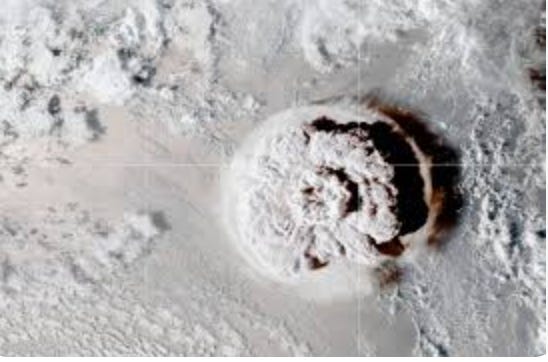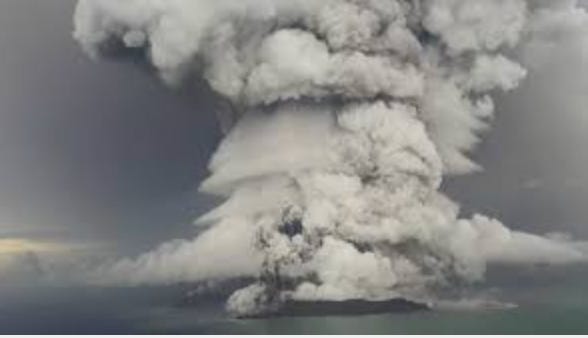150 Million Tons of Water Vapor Injected Into Atmosphere by Hunga Tonga Eruption
150-million-tons-of-water-vapor-injected
Climate-Industrial-Complex doesn’t talk much about volcanos John Leake Oct 04, 2024
Living in a world in which we are constantly barraged with information, it is easy to remain unaware of even earth moving events if our media doesn’t direct our attention to them. A couple of days ago, I read a column by fellow Substack author, Jeff Childers in which he mentioned the Hunga Tonga-Hunga Ha’apai volcanic eruption (from Dec 20, 2021 – Jan 15, 2022) in the South Pacific.
Hunga Tonga erupted with the explosive equivalent of a 61 megaton (61 million tons of TNT) nuclear bomb and released 150 million tons of water vapor and vast quantities of other gasses into the atmosphere. The following images taken from outer space will give the reader some sense of the blast’s magnitude.


Here is a video of the blast taken from outer space:
https://www.youtube-nocookie.com/embed/yIn9ZqWG1xg?rel=0&autoplay=0&showinfo=0&enablejsapi=0
As some readers may know, water vapor is a far more potent greenhouse gas than carbon dioxide.
Last December, NOAA Research published a paper titled “A volcanic eruption sent enough water vapor into the stratosphere to cause a rapid change in chemistry.” While we are often told that human activity is primarily responsible for climate changes, the following passage from the article suggests that the role of human activity and possible human intervention in the atmosphere remains poorly understood at best.
The tremendous amount of water vapor that this volcano sent to the stratosphere led to a rapid production of sulfate aerosol particles that we were able to observe within days of the eruption,” explained Asher. Under normal atmospheric conditions, sulfate aerosols form from sulfur dioxide on a timescale of about a month. In this case, rapid measurements provided critical clues for determining the chemical and microphysical processes required to cause these effects – clues that would have vanished if the measurements had been taken a month later.
Such measurements are critical for furthering scientific understanding of aerosol processes in the stratosphere, which remain one of the largest sources of uncertainty in climate predictions. Volcanic eruptions in particular are of significant interest because they are considered natural analogs for stratospheric aerosol injection — a proposed method of climate intervention that would spread reflective particles like sulfur dioxide in the stratosphere to intercept solar radiation and cool the Earth’s surface.
Note that the NOAA report mentions nothing about the possible insulating (greenhouse) effect of such a vast quantity of water vapor injected into the atmosphere. The authors are primarily interested in sulfur dioxide as a cooling agent, possibly because they have been incentivized to favor the harebrained stratospheric aerosol injection programs that are currently in the works.
